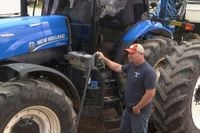Farmers across the United States are sounding the alarm as the 2025 harvest season unfolds, warning of dire consequences if urgent help is not forthcoming to move their record-breaking bumper crops. The situation, described by some as "farmageddon," is the result of a perfect storm: trade wars, stubbornly high inflation, soaring interest rates, and immigration policies that have disrupted the labor supply. The much-anticipated trade agreements that many hoped would materialize following President Donald Trump’s imposition of tariffs on major agricultural trading partners have failed to appear, leaving farmers in a precarious position as they begin to reap this year’s yield.
“It just seems like things have stalled all summer long,” said Brian Warpup, a corn and soybean grower managing 3,900 acres in Indiana, as reported by CNN. “We’re always hopeful that those negotiations are moving forward, but yet with harvest here, patience may be running thin.”
The troubles for U.S. farmers are widespread and multifaceted. While labor shortages plague West Coast operations—thanks in part to tighter immigration enforcement—Midwestern farmers are struggling with a different dilemma: they simply can’t sell what they’ve produced. China, the world’s largest soybean importer, has turned its back on American soybeans in 2025, opting instead for Brazilian imports. According to the U.S. Department of Agriculture, the American soybean export market was worth nearly $25 billion as recently as 2024, but those numbers are now in jeopardy.
Commodity prices, which soared in 2022, have fallen, while the costs of fertilizer, seeds, and equipment have only climbed higher. Many farmers are running out of space to store unsold grain. Ryan Frieders, who grows corn and soybeans in Illinois, likened the storage crunch to “a tidal wave of problems coming towards Illinois.” Some, like Warpup, are selling corn earlier than usual just to make room for soybeans, while others are paying extra for grain elevator storage.
The economic squeeze has led to a sharp increase in farm bankruptcies. The American Farm Bureau Federation reports a 55% rise in 2024, and University of Arkansas economist Ryan Loy confirmed the trend continued into the first quarter of 2025. Caleb Ragland, a Kentucky soybean farmer and president of the American Soybean Association, warned, “It’s going to mean that there’s going to be farmers that are so far at the end of their rope, not able to meet their financial obligations.” He also pointed to the tragic reality that farmers already face higher suicide rates than the general population, a risk that could become more acute if the situation doesn’t improve.
Despite these mounting pressures, immediate relief remains uncertain. Trump’s much-touted One Big Beautiful Bill Act promises a $59 billion boost to farm safety nets and tax breaks for equipment over the next decade. However, congressional aides note that these increases won’t kick in until the 2026 crop year—too late for many facing hardship now. Meanwhile, the 2018 Farm Bill, which has been extended twice, is set to expire on September 30, 2025, with no new legislation finalized as of that date.
On September 20, 2025, Trump officials, led by Treasury Secretary Scott Bessent, met with a Chinese delegation in Madrid for trade talks. Yet, as of publication, it remains unclear if any breakthrough was achieved that might reopen Chinese markets to American soybeans. President Trump himself acknowledged the issue in a recent Truth Social post, expressing hope that China would “quickly quadruple its soybean orders.”
Lawmakers are scrambling for solutions. Senate Agriculture Chairman John Boozman (R-Ark.) stated, “Our ongoing, constant efforts to gather farmers’ feedback have always proved tremendously helpful as we make clear to the administration and colleagues in Congress how serious the situation is in rural America.” Some, like House Agriculture Chairman Glenn “GT” Thompson, have floated the idea of using tariff revenue to support farmers, but Democrats argue that the fastest fix is for Trump to end the trade war with China. “Our farmers have spent generations building these export markets, only to have them closed off by haphazard tariffs,” said Sen. Amy Klobuchar, the top Democrat on the Senate Agriculture Committee, to CNN. “We learned from the trade war during the President’s first term that these markets don’t come back overnight.”
Indeed, the wounds from the first round of tariffs are still raw. During Trump’s first term, a $28 billion federal bailout was required to stem the bleeding, largely funded by blue states, according to reporting by the Tennessee Lookout. Tennessee soybean farmers alone lost $40 million during the 2018 trade disruptions, even after receiving federal aid, a University of Tennessee study found.
Stefan Maupin, executive director of the Tennessee Soybean Promotion Council, described the current situation as “significant and desperate.” He told the Tennessee Lookout, “None of the crops that farmers grow right now return a profit. They don’t even break even.” Inflation, driven in part by ongoing tariffs, has pushed up costs, and with China’s demand shifted to Brazil, many farmers are forced to borrow against their assets just to survive. “Right now this year and looking like going into next year, the crop will not cash flow,” Maupin said. Even if a new trade deal emerges, he warned, farmers will still face debt and tough choices.
Some farmers are pinning their hopes on new domestic markets, such as states like California and Washington, which are setting ambitious fuel standards. However, these states are moving to reduce the role of biomethane and limit the use of crop-based biofuels. California’s Air Resources Board, for example, is capping biofuels at 20% and prioritizing waste-based feedstocks over traditional crops, a policy shift that has agricultural trade groups deeply concerned.
Despite these challenges and the political contradictions—many farmers who decry “socialism” are now seeking government aid—support for Trump in rural America remains strong. In the 2024 election, he won rural voters by a staggering 40-point margin, according to Pew Research Center. Yet, frustration is mounting. Chris Gibbs, an Ohio farmer and former Republican county chairman, called previous bailouts “hush money to keep them sedated.” He argued, “Farmers can’t wait any longer. They’re squeezed on cash flow. They’re having trouble renewing loans—commodity loans. We’re in a mess—a cash flow mess. And farmers aren’t going to be able to pay the bills. So the administration needs to find some solutions.”
The Purdue University-CME Group Ag Economy Barometer Index echoed this sentiment in August 2025, showing farmer optimism sinking for a third straight month. While livestock producers have been spared the worst of the price drops and market closures, crop farmers are feeling the full brunt of the crisis. Eric Euken, a seventh-generation Iowa farmer, summed up the uncertainty: “We don’t know what’s happening next from day to day.”
For now, the future of American farming hangs in the balance, with growers waiting for a lifeline from Washington—or a sudden turn in global markets. The next few weeks will prove critical as policymakers, industry leaders, and farmers themselves grapple with choices that could shape rural America for years to come.




